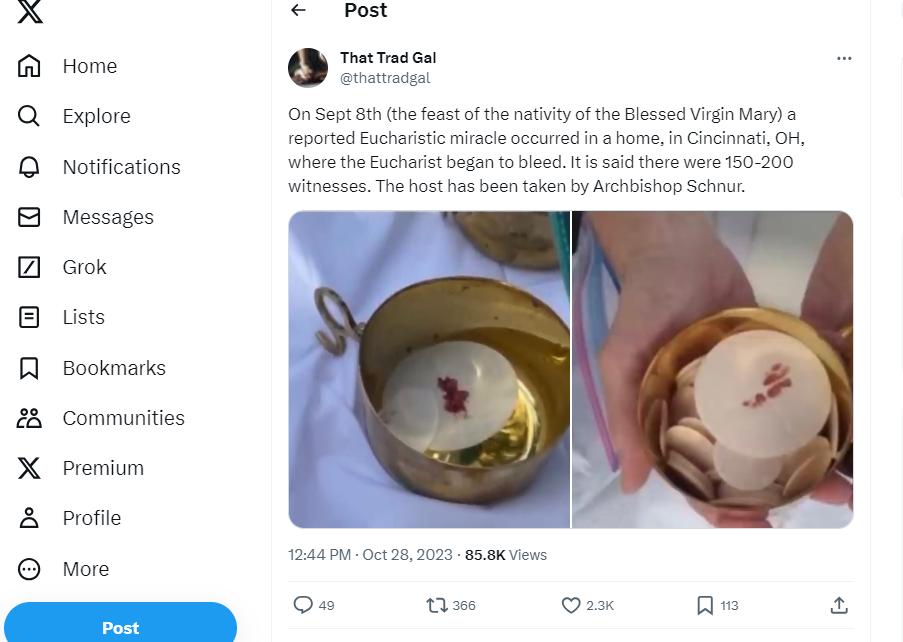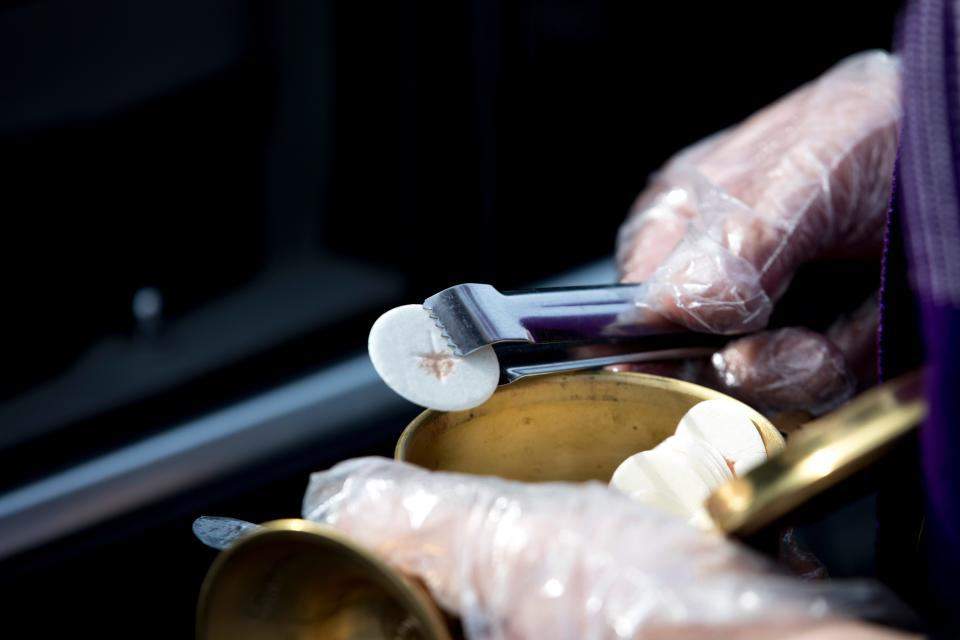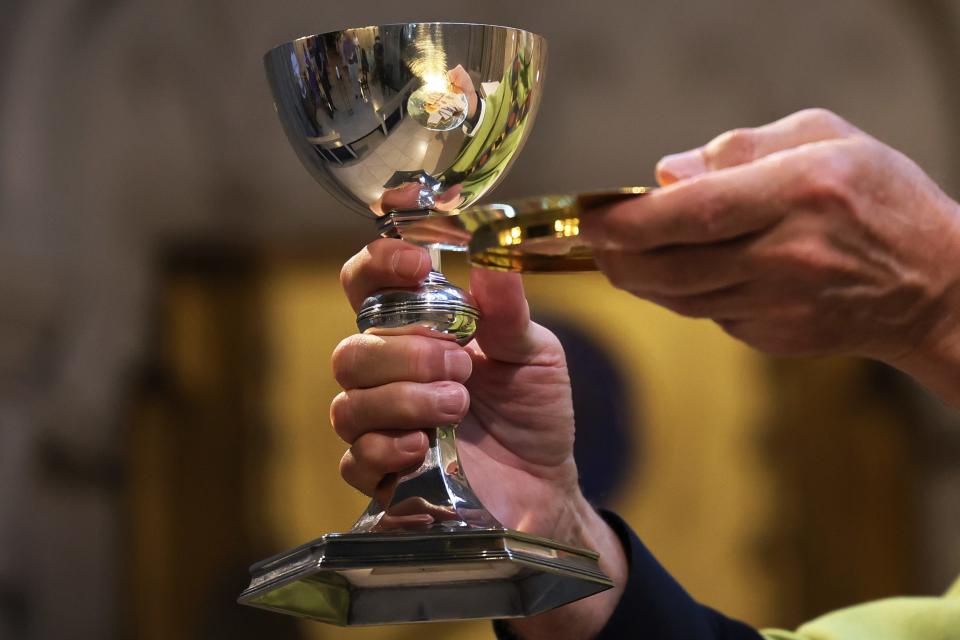A miracle in Cincinnati? Some Catholics say they saw 'manifestation' during communion
- Oops!Something went wrong.Please try again later.
The photos of a communion wafer with a large red smudge on it started popping up on social media and religious websites in October.
Those who shared the images made an extraordinary claim: The smudge was blood that suddenly appeared during a Catholic Mass in Cincinnati on Sept. 8.
Believers hailed the red-stained wafer as “incredible” and “a miracle,” proof that Jesus Christ is present in body and spirit during Holy Communion. Skeptics called the claims “fake” and “nonsense,” proof that the gullible are no match for internet tricksters.
But in the Catholic faith, which teaches that miracles are rare but real, only the church gets to decide if what happened that day in Cincinnati was supernatural or merely unusual.
Was it a hoax? A natural occurrence?
Divine intervention?
The church tries to answer those questions through a process that blends modern science and the mystical. It leans on evidence, such as lab tests and witness interviews, as well as 2,000 years of religious tradition.
The work isn’t exactly a CSI investigation – there’s no scientific test to prove a miracle – but the church’s goal is to determine whether a potentially miraculous occurrence can be attributed to anything other than an act of God.
In Cincinnati, that work began when some attendees at the Sept. 8 Mass claimed they witnessed a "manifestation" on the communion wafer and the photos showed up on social media. When curious Catholics started calling the Archdiocese of Cincinnati for more information about the claims, church officials urged them not to jump to conclusions.

A few unconfirmed reports and some photos on Facebook fell short of the evidence the church requires to authenticate a miracle, said archdiocese spokeswoman Jennifer Schack.
But they were enough to get the attention of church officials, who decided to look into the matter.
“There’s always going to be a degree of caution. There’s never a presumption that this is a miracle,” said the Rev. David Endres, a professor of historical theology at Mount St. Mary’s Seminary and School of Theology in Cincinnati.
“If there’s a transformation, they’re going to ask the question about whether this can be proved through science.”

Miracle investigations go back centuries
To understand why the church might consider blood on a communion wafer miraculous, it’s important first to understand what the church teaches about Holy Communion.
Catholics refer to the wafer, typically a thin piece of unleavened bread, as the Eucharist, a term that originates from the Greek word for thanksgiving. During communion, the faithful believe, the Eucharist and the wine presented with it are transformed, literally, into Christ’s body and blood.
This mystical process, known as transubstantiation, occurs after the priest consecrates the wafer, though no physical change in the bread and wine is visible.
Throughout the history of the church, however, priests and lay people have occasionally reported witnessing a “Eucharistic miracle,” during which the wafer undergoes a visible transformation.
One of the most famous cases occurred about 1,300 years ago in Lanciano, Italy, when a Catholic monk claimed a communion wafer turned to flesh and blood before his eyes. The monk said the sight of the bleeding Eucharist strengthened his Catholic faith, a common refrain among those who claim to have witnessed miracles.
The church kept the Lanciano wafer as a holy relic, and tests in the 1970s found human blood and tissue. Skeptics argue the tests don’t rule out a hoax perpetrated by anyone, including the monk, at any time in the past 13 centuries. But the church recognizes the event as a miracle and the site is now a shrine popular with Catholic pilgrims.
New claims and investigations continue today. Sometimes science rules out the supernatural – a red fungus occasionally is mistaken for a bleeding Eucharist – and sometimes the church finds its answer in the divine.
In the 21st century, according to the Jesuit-run Magis Center, the Catholic Church has recognized four Eucharistic miracles worldwide.
For the purported miracle in Cincinnati to join them, the church would need more to go on than some photos posted on social media by people who offered plenty of praying hand emojis but little else to back up their claims.
One such post on X, formerly Twitter, included two photos of a red-smeared wafer that were viewed more than 85,000 times. The post declared that a “Eucharistic miracle occurred in a home in Cincinnati, OH.”
The photos included no identifying features, such as a person or a recognizable location, but they soon proliferated on Facebook, X and at least one website, which linked to a YouTube video about the Cincinnati Mass.
None, however, provided information beyond the photos and the anonymous claims about a miracle. And a few weeks later, in November, one of the same photos was repurposed by someone else on Facebook to support claims of a similar “miracle” in Ireland.
“Irish Priest Reports Extraordinary Eucharistic Miracle!” the Facebook post said.

Some saw a 'manifestation' on communion wafer
As the images multiplied online and commenters debated their authenticity, church officials in Cincinnati tried to piece together what happened, said Schack, the archdiocese spokeswoman.
They learned that the Mass in question took place in a private home in Cincinnati on Sept. 8, a Catholic feast day celebrating the birth of the Virgin Mary.
Schack would not confirm the location of the Mass or identify the participants, but she said the archdiocese had given permission to two priests to lead the Mass at a location other than a church or chapel. During Holy Communion, she said, several attendees reported “some form of manifestation” on the communion wafer.
She wouldn't say what, exactly, that means. But it stirred things up at the Mass.
“There seemed to be a general excitement,” Schack said of the attendees.
What happened after that excitement is a little fuzzy. Despite claims on social media that one of the priests took the Eucharist to Archbishop Dennis Schnurr, which would have allowed church officials to begin a formal investigation, Schack said the archdiocese doesn’t have the red-stained wafer and never did.
She wouldn’t name either of the priests involved, but one of them, the Rev. Jeff Von Lehmen, was mentioned in some social media posts. When asked about the Mass and the missing Eucharist, Von Lehmen declined an interview but sent an email that he said was intended for “all people who inquire about the miracle.”
“Most private revelations or manifestations are just that, private and a matter of personal discernment,” Von Lehmen wrote. “Eucharistic miracles do happen. Some are confirmed. Study them!
“Realistically though it is impossible for the Church to make an inquiry (different from Facebook inquisition) into every possible miracle.”
He declined to provide additional details about the Mass, including the name of the other priest, and wouldn't say whether the photos that appeared online in October were taken at the Mass.
Schack said the archdiocese’s inquiry determined that the other priest was visiting Cincinnati from the Philippines and that he took the communion wafer with him after the Mass. She said he left town a short time later.
“Therefore,” Schack said, “the archdiocese is unable to corroborate anything regarding the authenticity of the alleged miracle.”
Without the missing Eucharist, there can be no formal investigation, no scientific tests and no determination of whether what happened qualifies as a miracle in the eyes of the church.
Endres, the historical theology professor, said faithful Catholics should be OK with that. He said it’s more important to appreciate the small miracle that happens every time they take Holy Communion, even if they never see a physical transformation.
For some, though, it’s a challenge to believe what they cannot see. A Pew Research Center poll in 2019 found that almost 7 in 10 Catholics said the bread and wine they consume during Mass are “symbols of the body and blood of Jesus Christ,” rather than the real thing.
Seeing the change happen during a miracle might remove such doubts, Endres said, but it shouldn’t be necessary to fully accept what the church teaches.
That’s why it’s called faith, he said.
“Faith is always beyond the senses, beyond what can be seen,” Endres said. “Faith is belief in things unseen.”

This article originally appeared on Cincinnati Enquirer: A Catholic miracle? Some in Cincinnati say they saw one in Eucharist

